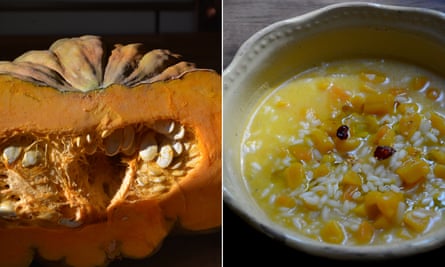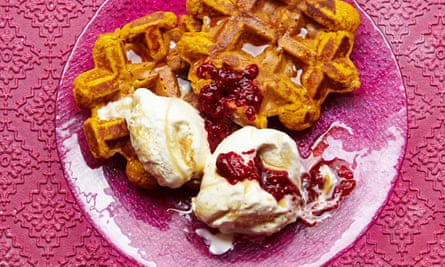At this time of year we are invariably confronted with two contradictory bits of culinary wisdom. First we are told that 12.76m pumpkins will be purchased, carved up and binned over Halloween, a shocking waste that could be ameliorated if we could make something delicious from our jack o’lanterns. But the first rule of pumpkin cookery has always been: don’t use pumpkins sold for carving.
It’s not quite that simple. You can use most supermarket pumpkins in most recipes – they are suitable, if not ideal. They are bred to have thin walls for easy carving and the flesh tends to be pale and watery. I once made a pie from a pumpkin with a sticker on it that said was edible, and I could make no higher claims for the result.
Also: once you have carved a pumpkin, stuck a tea light in it and left it on the doorstep overnight, it’s pretty well finished as a foodstuff. You certainly wouldn’t want to make anything to eat from what’s left in the morning. In any case, the best time to cook with a huge supermarket pumpkin is on the first of November, when the shops are basically giving them away.

For most recipes, however, seek out the rounder, smaller, fleshier varieties. Generally, you’re better off trying to carve a cooking pumpkin than trying to cook a carving one. These finer pumpkins are usually found in the veg aisle next to the rest of the squashes.
Hugh Fearnley-Whittingstall, who uses grated pumpkin flesh in his pumpkin and raisin tea loaf, has this to say about the difference: “I’d have no compunction about sampling any squash you put in front of me, but I’d want to know more about a pumpkin because many are developed for size, not flavour. As a general rule, be suspicious of anything larger than a melon, particularly in the run-up to Halloween.”
A lot of recipes call for pumpkin puree. This is best derived through roasting: halve your pumpkin, scrape out the pulp and seeds, cut it into rough chunks, drizzle with oil and bake on a tray, skin side down, until tender. Once cool, you should be able to pull the skin off and mash what’s left until smooth. How much puree you get from a pumpkin will vary, so allow a bit of leeway. And it’s slightly more work than it sounds in my description, so you might want to get this part out of the way the day before you cook.
The classic, American-style pumpkin pie can mystify – even upset – people who were not trained from childhood to like it. “Are you telling me that thing is a pudding?” is all my wife could say the first time I made one for her.
Felicity Cloake’s perfect pumpkin pie will at least get you off on the right foot. She offers the usual advice about selecting a decent variety, but if you insist on using your giant carving pumpkin, leave plenty of extra time for the watery puree to drain.
For those who struggle with the idea of pumpkin pie as a pudding, there are a number of savoury alternatives. This pumpkin picnic pie, from Calum Franklin, of Holborn Dining Rooms, exploits the affinity between pumpkin and sage, as does Anna Jones’s gruyere and pumpkin pie. Claire Thomson’s spiced filo pumpkin pie combines pumpkin with feta, ricotta, honey and pine nuts.

Pumpkin also makes an excellent base for soup. Jamie Oliver has an entry-level version spiced with chilli and coriander seeds. Rachel Roddy’s pumpkin and rice soup is similar, but omits the roasting step – you just add the diced pumpkin straight to the pot. For a slightly more exotic option, try James Martin’s Thai pumpkin soup.
With his baked pumpkin and spiced chickpeas, Nigel Slater produces a rather exotic supper with very little effort and a few store cupboard ingredients. The pumpkin is simply sliced into wedges and baked, and the tinned chickpeas are drained, rinsed and heated up in a paste made from lime juice, garlic, ginger and coconut cream. Slater’s pumpkin with rice and beetroot isn’t much more complicated, although it may take a bit longer – the ingredients are arranged in alternating layers in a deep dish and baked for an hour.
Pureed, spiced pumpkin is a common pasta filling in Italy, either in ravioli or tortelli. For the ravioli, the puree is mixed with crushed amaretti biscuits, nutmeg and parmesan. The tortelli recipe, from the classic Italian cook book The Silver Spoon (Il Cucchiaio d’Argento), uses breadcrumbs instead, but both dishes are dressed with a butter and sage sauce.

If you find it hard to conceive of pumpkin pie as a dessert, there are a few more obvious sweet options. Pumpkin and almond waffles are a perfect seasonal treat for anyone who likes pudding for breakfast. Thomasina Miers’s recipe for roast pumpkin cake with ginger icing calls for a specific breed of pumpkin: delica, which has grey-green skin and bright orange flesh. You may spend more time shopping than cooking.
Tom Hunt’s pumpkin doughnut muffins are a good way to use up that last bit of leftover pumpkin – just 200g of cubed flesh is required to give them a lovely orange hue. Pumpkin ice-cream isn’t really an ice-cream recipe, just a mash-up of vanilla ice-cream, pumpkin puree and the usual spices.
When the cooking is over and done with, you’ve still got the pumpkin seeds, which are a great source of protein, magnesium, copper, iron and zinc. The good news is that you can harvest great handfuls of seeds, suitable for roasting, from any old carving pumpkin. The bad news is they are not just seeds, but seeds in hulls. The outer layer is technically edible, but not very nice, so you can either eat them whole and spit out the hulls (which I don’t recommend) or shell them individually by hand (which I also don’t recommend), or crack a whole batch under a rolling pin before boiling the shells off (which I still don’t recommend). All of it seems more trouble than it’s worth, but here’s a little seed-processing tutorial which, if nothing else, will make you feel grateful for the pre-hulled ones they sell in shops.
from Lifestyle | The Guardian https://ift.tt/35FDFzD
via IFTTT

comment 0 Comment
more_vert